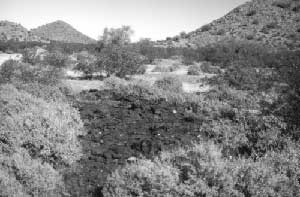MENU
|
| |
Confinement and Ethnicity: An Overview of World War II Japanese American Relocation Sites by J. Burton, M. Farrell, F. Lord, and R. Lord |

|
|
| |
Chapter 4 (continued)
Gila River Relocation Center
Outlying Area
The fields once farmed by the evacuees are still under cultivation and most of the outlying developments of the relocation center, such as the chicken, hog, and dairy farms, were located within what are now irrigated fields and orchards (see Figure 4.21). Some abandoned ditch segments located in areas farmed by the evacuees may be left from the relocation center use (Figure 4.108).
 Figure 4.109. Gila River Relocation Center Dairy farm. (adapted from Sullivan, et al. 1987) |
The location of the elaborate baseball field just outside the southeast corner of Butte Camp is now an olive grove. Several features of the ballfield were apparently recorded by Sawyer-Lang (1989; Locus 12), including remains of the dugouts and backstop. None of these features remain today.
At least one of two pet graves identified by Sawyer-Lang (1989) still remains. Located in an orange grove southeast of Butte Camp, from Sawyer-Lang's description it appears to have been refurbished (Figure 4.110). It includes inscriptions written in the wet cement in both Japanese and English. The English text reads: "‘Guard upon/all livings"/Dog, Kookey Yokogama/Died Jan 14th 1945," the Japanese text reads "Guard upon all livings/The Spirit of Kookey." The other pet grave had both English and Japanese inscriptions as well. The English text read "here lies chubby/fujiyama/ oct 19, ‘43"(Sawyer-Lang 1989). It could not be relocated.
As mentioned above, there are substantial remains at both the Canal Camp and Butte Camp sewage treatment plants. At the sewer farm locations there are only faint furrows and desert vegetation today. North of Canal Camp a well and several foundations from the camp water system remain (Figure 4.111).
 Figure 4.118. Flattened cans at the Gila River Relocation Center landfill. |
 Top
Top
Last Modified: Fri, Sep 1 2000 07:08:48 pm PDT
http://www.cr.nps.gov/history/online_books/anthropology74/ce4n.htm
![]()


